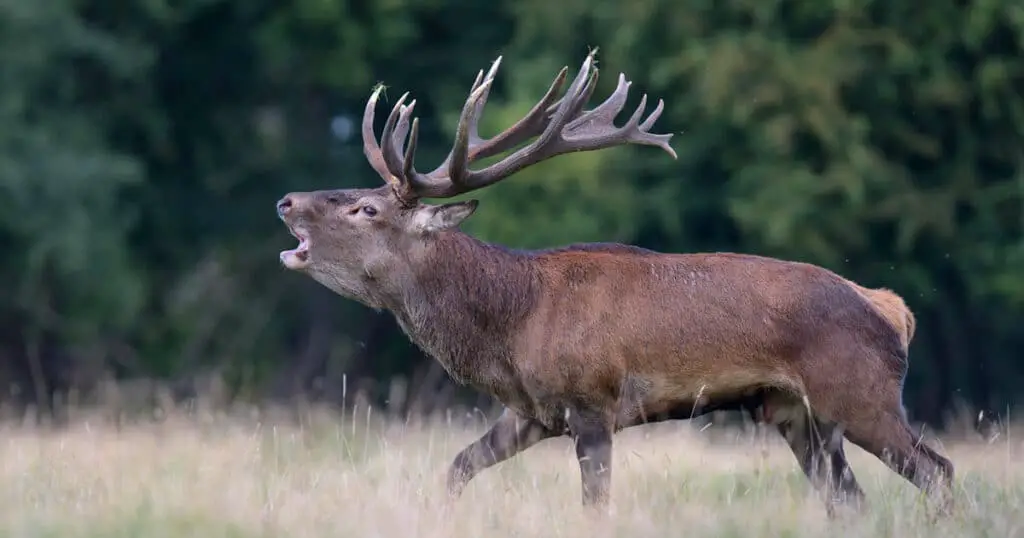From the barking deer of Asia to the unmistakable bugle of a bull elk, deer make a variety of sounds. In this article, we’ll answer the common question What sound does a deer make? and discuss all of the different sounds made by different species of deer, and explore what those sounds mean.
Each type of deer will usually make a range of sounds rather than just one.
Maybe you’ve assumed that deer don’t really make much of a noise, as they’re so often silent in the woods. The fact of the matter, however, is that deer do make sounds. If you’re getting started as a hunter, you will need to learn some of these sounds.
What Do Deer Sound Like in the Woods?
Deer will often try to stay quiet in the woods, as they want to evade the detection of predators. They actually do make many noises, though.
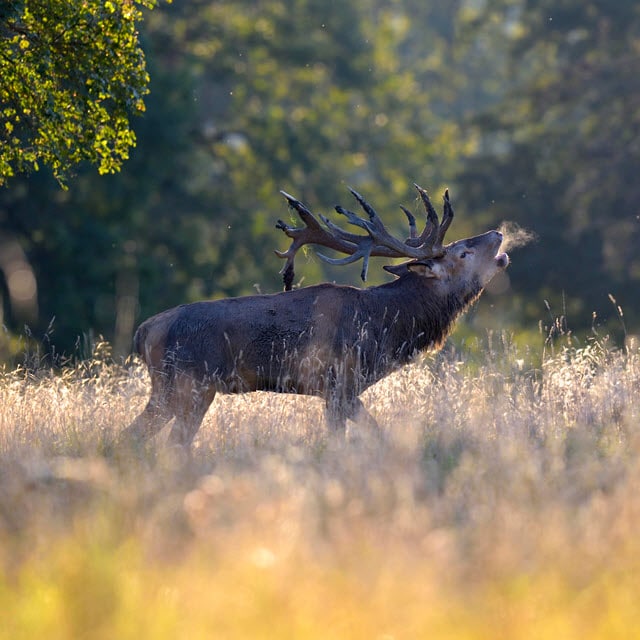
So, What Sound Does a Deer Make?
Deer make different sounds to express different things, particularly during the rut when male deer become loud and brash to attract females. These females will, in turn, often bleat to signal estrus and attract the buck or stag they wish to mate with. Young deer make sounds to communicate with their mothers.
The most common sounds deer make include:
- Snorting
- Sniffing,
- Stomping, and
- Wheezing.
And of course different species of deer have sounds that are unique to them. The North American Elk‘s iconic bugle is one of the most distinct and unforgettable sounds in the animal kingdom.
And the Muntjac Deer of Asia (often known as the “barking deer”) has a unique sound all of its own.
Deer hunters need to understand the different noises these animals make. Some hunters learn how to make the different deer noises in order to trick deer into thinking they’re a fellow animal instead of a human, and lure them in close.
Different Kinds of Deer Noises
Let’s go over some of the most common kinds of noises that deer make, as well as the reasons why they make them.
Snorting
Snorting is a noise deer make when it believes danger is near. If you’re hunting and you hear a deer snort, it’s likely that the animal has detected you. The snorting sound is a bit like a sneeze. When a deer snorts, it will typically lift its tail and make a quick escape.
Other deer will hear the snort, and this will let them know about your presence. The snort is one of the best known whitetail deer sounds.
Sniffing
The deer’s sniffing noise sounds similar to the noise humans make when smelling something. When deer sniff, they’re doing it to make out the smell of things around it.
For example, they may be trying to sniff out a predator or perhaps a hunter. It’s one of the ways deer can detect danger they cannot yet see.
Stomping
A deer will often stomp when it thinks danger is nearby. This is a warning to potential predators, and to other deer in the herd who may be nearby.
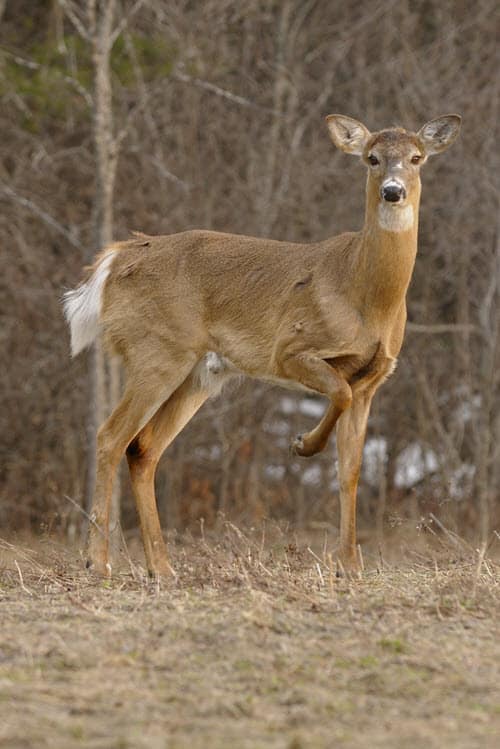
Stomping will often accompany other noises such as sniffing.
Wheezing and Snorting
Wheezing and snorting are noises a deer will make when angry. They’ll also use these to show dominance over rivals in the area.
These noises tend to be combined into one called the snort-wheeze. It’s often made by bucks competing over the same territory.
Noises Specific to Bucks
What sound does a buck make? You guessed it – there are certain noises that only bucks (male deer) make.
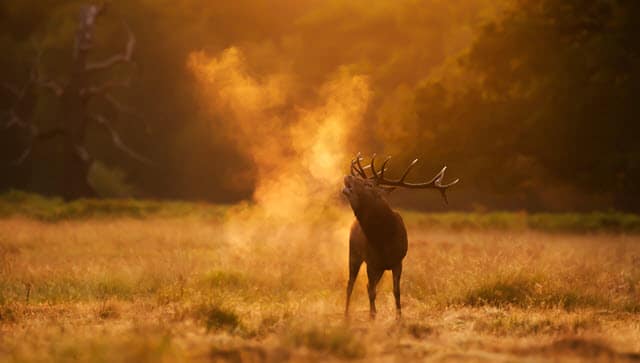
These noises vary slightly from species to species, but most bucks communicate for the same reasons – to attract females and demonstrate their strength and dominance to scare away weaker male deer.
Antler Rattling
Antler rattling is a noise made when two male deer fight. It’s simply the sound of their antlers coming together. Before the fighting begins, the deer create a rattling sound by hitting their antlers together.
Buck Grunt
This is a sound bucks will make to demonstrate dominance. The male cervid will use this sound when claiming a territory and pursuing female deer.
Noises Specific to Does
What sound does a female deer make? Let’s take a closer look at some of the common noises that females will make.
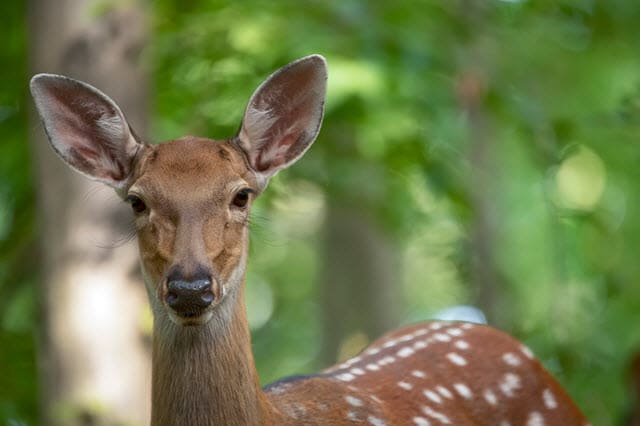
Doe Bleat
Bleating is a noise that does tend to make when interacting with other deer. This sound has a noticeable vibration and a high pitch. Some people compare it to the noise a goat makes.
Does will often bleat when they’re together in a group. They may also bleat to their fawns.
Doe Grunt
A doe’s grunt is similar to a buck’s, but it has a significantly higher pitch. A doe’s grunt has a different purpose than a buck’s grunt. It’s a social sound and they use it when in groups of other deer.
This is also a sound that the doe will make when letting her fawns know that it’s time to feed or go somewhere else.
Estrus Bleat
The estrus bleat is a bleat the doe makes when in estrus. It is meant to attract bucks during the mating season.
Noises Specific to Fawns
There are also noises that only fawns make. Fawns are baby deer.
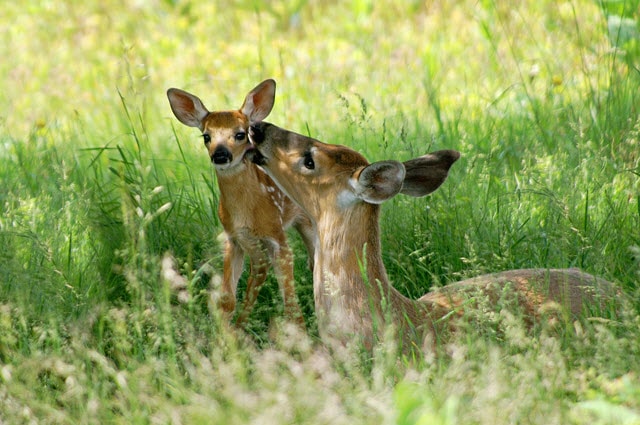
Fawn Bleat
Like a doe, fawns make a bleating sound that sounds a bit like a goat. They do this as a sign of happiness and contentment. A fawn bleat is higher pitched than a doe bleat.
Fawns will bleat in several different circumstances, including when they’re socializing with other fawns and deer in the herd, as well as their mothers.
Fawn Distress Call
The fawn distress call is the noise a fawn makes when it needs to get help from its mother. It can have a similar sound to a human cry.
The fawn distress call will quickly get the mother’s attention and assistance. How loud a fawn distress call will be depends on how frightened the fawn feels.
Nursing Whine
Fawns make this noise when they’re nursing, and experts believe they do it to create a stronger mother-fawn bond. This is a quiet noise, and you’re not likely to hear it if you’re at a distance. The nursing whine sounds similar to its name. It’s a whining noise that fluctuates between quiet and slightly louder pitches.
What Sound Does a Deer Make when Scared?
The main noise an adult deer makes when it’s scared is a snort. This is a loud sound and it will often be accompanied by stomping and tail-flagging. This is done to tell other deer in the area about potential danger.
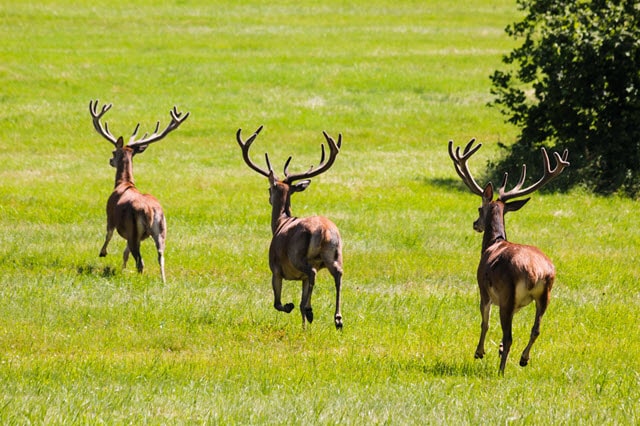
If a fawn is scared, it will usually make a squealing bleat. This is especially true if it’s away from its mother. A frightened fawn will run and search for other members of the herd.
Whitetail Deer Sounds
Whitetail deer make all the sounds we’ve already outlined. The vocalizations they make are categorized into conversational noises and breeding sounds.
- Conversational sounds are noises deer make to communicate with other deer.
- Breeding vocalizations, on the other hand, are made during the breeding season.
An interesting fact about deer vocalizations is that their meaning may depend on context. In this way, they’re similar to human language.
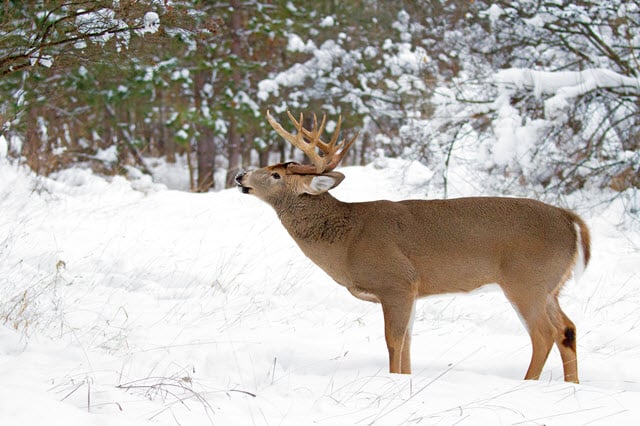
As well as vocalizations, whitetail deer have other ways of communicating, such as with their antlers (for territorial purposes). Male deer make antler rattling noises when sparring for territory.
In addition to the noises we’ve already discussed, there are other sounds that whitetail deer make. Here they are below:
Trailing Grunt
Whitetail bucks make this sound when they’re pursuing a doe in estrus. This sound comes in brief bursts. Sometimes it can be made in a rhythm, specifically the rhythm of the buck’s walking.
Hunters often use this call in the time just before the breeding season, often called the pre-rut. It can fool bucks into coming in close, thinking there is competition in the area.
Social Grunt (also called a Contact Grunt)
The social grunt is a sound bucks make to communicate with other members of the herd. This is an important call for hunters to know.
Buck Roar
Bucks may make a sound close to a roar during certain circumstances, such as when they’re annoyed or excited. Again, this is a deer sound most often heard as part of the deer’s broader mating habits.
Table: Deer Species and their Sounds
Now let’s take a look at a chart where we set out all the different sounds deer make and the types of deer that make them.
Specifically, this table shares the sounds made by Whitetail Deer and Mule Deer, as these are the most common kinds of deer in North America.
As we will see, White Tailed Deer and Mule Deer both make the same general kinds of sounds. The main differentiation tends to be that mule deer noises tend to have a deeper and throatier sound than whitetail deer.
If you plan on hunting mule deer as well as whitetail deer, you should try to practice getting the right pitch so that you can call deer more effectively.
| Deer Sound | Type of Deer |
|---|---|
| Snort Wheeze | White Tailed Deer / Mule Deer |
| Sniff | White Tailed Deer / Mule Deer |
| Stomp | White Tailed Deer / Mule Deer |
| Antler Rattling | White Tailed Deer / Mule Deer |
| Buck Grunt | White Tailed Deer / Mule Deer |
| Doe Bleat | White Tailed Deer / Mule Deer |
| Doe Grunt | White Tailed Deer / Mule Deer |
| Estrus Bleat | White Tailed Deer / Mule Deer |
| Fawn Bleat | White Tailed Deer / Mule Deer |
| Fawn Distress Call | White Tailed Deer / Mule Deer |
| Nursing Whine | White Tailed Deer / Mule Deer |
| Buck Roar | White Tailed Deer / Mule Deer |
| Social Grunt (contact grunt) | White Tailed Deer / Mule Deer |
| Trailing Grunt | White Tailed Deer / Mule Deer |
| Buck Bawl | Mule Deer |
| Fawn Bawl | Mule Deer |
Mule Deer Don’t Communicate as Much
When comparing White Tailed Deer with Mule Deer, Mule Deer tend not to be as communicative and social as whitetail, but they do make sounds for communication similar to other kinds of deer.
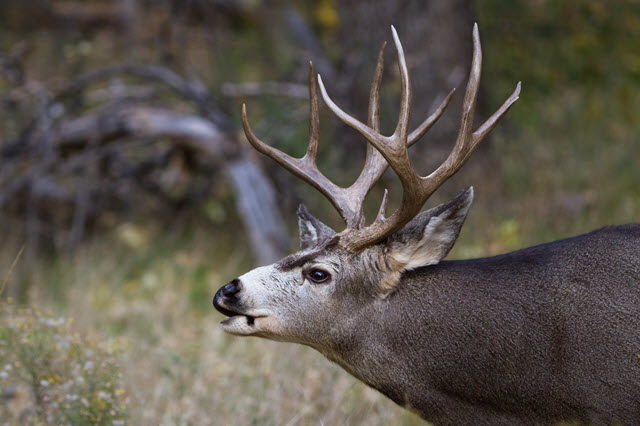
In addition to sounds the whitetail deer also make, mule deer make a few unique noises. One of these is the buck brawl. This is a sound made by male mule deer when they want to attract the attention of other deer. They may do this when they just want other deer around.
Why Do Hunters Need to Know Deer Sounds?
There are two main reasons why it’s helpful for hunters to know deer sounds.
- One is that it helps them detect the animals in the woods, and
- The other is that hunters can learn to make the sounds themselves in an effort to lure their quarry.
If you’re a deer hunter and want to lure a buck in close for a clean shot, you can make vocalizations that will interest them and bring them close. For example, you can make the buck think that there is a competitor in the vicinity that they need to check out. You can also use doe calls to lure deer.
Some hunters bring some shed antlers to rattle, to imitate the sound of deer rattling that bucks make when they’re in conflict.
Again, this will make bucks believe there are other male deer in the area competing for his territory and the females in it.
Other Hunting Strategies
Recognizing and being able to replicate deer sounds is certainly an indispensable strategy in hunting deer, but there are others you should use too.
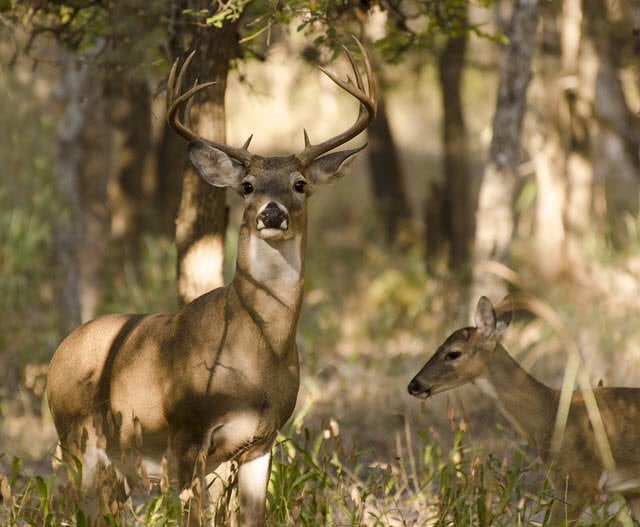
For example, you should look for deer bedrooms. The “bedrooms” are the places where deer bed down. These tend to be quite well-hidden, and this is especially true in the times of the year just before and after the rut (breeding season).
The exact hunting strategies you should use will depend on where you’re hunting and whether you’re hunting whitetail deer or mule deer, and the conditions of the local deer habitat.
One of the most important strategies no matter what and where you’re hunting is to remember the wind. Your scent, of course, is conveyed to animals in the area by the breeze. Know the direction of the wind and the strategies you must use to cut down on how easy it will be for deer to detect you.
Now You Understand Deer Sounds
Clearly, deer aren’t the silent animals you thought they were. Both whitetail and mule deer make a wide range of sounds, and so do the many other species of deer around the world.
You can use your knowledge of this when hunting, or simply enjoying time in the woods.

